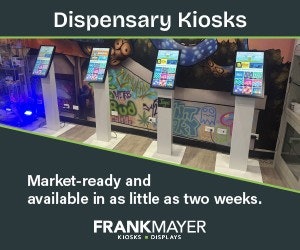
Recent legalization has added fuel to the green rush. As it makes its hurried way toward the East Coast, this wave of momentum feels like rocket fuel behind the maturation of the cannabis industry. While we’re far from a consistently regulated, low-stigma and widely embraced market, there are already multi-state operators (MSOs) like Cresco Labs and Curaleaf that are well poised to expand their reach and welcome in anxious to expert consumers with well-tested—and funded—brands, products and operations.
That’s not to say that leadership is guaranteed to these players—far from it, especially when you take into account how fragmented the market is—but it does give us an indication of where things may be headed. Most importantly, we can see how integral it will be to precede costly cannabis market entry with a compelling brand to help you rapidly compete with massive vertically integrated competitors who may well be situated to beat on cost, data and scale.
When thinking about the potential for cannabis branding, it may be useful to look to the beer industry’s Big Beer vs. Craft Beer dynamic for some clues.
For many years, the beer industry was dominated by a few major players, such as Coors, Budweiser and Heineken. For over fifty years following Prohibition, there were only a few hundred regional breweries, until President Jimmy Carter signed a bill legalizing homebrewing. Over the next ten years, the number of local beer brands began to grow, culminating in a craft beer renaissance beginning in the 1990s and exploding with the IPO of Boston Beer Company, the makers of Sam Adams, in 1995. With no signs of slowing down, Craft Beer has been giving Big Beer a run for its money and has forced them to take notice. In 2017, Heineken acquired Lagunitas Brewing Company for $1 billion, according to some estimates.
It is possible that when MSOs (e.g. Big Cannabis) eventually plateau in growth in the context of a flooded industry, the next logical step may be the snowballing acquisition of smaller, niche brands (e.g. Craft Cannabis) to expand their consumer base and offerings.
In anticipation of a potentially similar future, a simple and clear brand that compellingly elevates what makes you special to bombarded consumers will be essential to quickly stand out, command a premium and build loyalty through crowded physical and digital shelves. Perhaps as well, it will become the next “Big Beer,” or be positioned well for a lucrative acquisition.
While the job of crafting a brand is easier said than done, we have some advice:
Avoid forming a shallow view of your audience
Cannabis is a magic ingredient equally enjoyable on its own as it is morphed into varying concoctions and potions—oils, brownies, balms and even pixie sticks—which is part of what makes the space so exciting from an innovation and delight standpoint. Its form, benefits and use cases can dramatically differ brand to brand, product to product, meaning starting from a deep understanding of what will appeal to your target audience is even more critical.
Yet, unfortunately, brands rarely seem to have that level of insight on who their audience is—often stopping short at demographic info and purchase behavior wrapped up in generic personas, e.g., “Rosa, the anxious newbie” or “Ronny, the sophisticated smoker.” While these provide some critical information, brands that succeed understand and connect in a deeper, more emotional and almost guttural way with their audiences. They know for Rosa and Ronny: Why do they do what they do? What are their deepest unmet needs? What do they love? What do they fear? Why? And what’s their Why behind that Why?
In a digital marketing-dominated world, it’s easy to understand how this happens. Quant-led decision-making and click tracking leads us to take hard data as supreme when understanding market opportunities, eschewing the power of additional qualitative exploration. Brands need both, but many stop at the survey rather than getting to know the people behind the responses through interviews and studies. Tapping into this magic will help you cut through with messaging that resonates and invest in innovations that solve audiences’ problems.
Focus on setting the next, rather than merely following trends
Full of rich lore and culture, cannabis brands have a plethora of material to draw inspiration from when crafting their stories and developing their image. Combine this with the potential for a cannabis brand to present as clinical and scientific as a pharmaceutical brand, to as outrageous and raw as an entertainment brand, and what you should get is a limitless avenue to build a differentiated brand – yet why is it so hard to do something different?
In fact, many cannabis brands seem to be stuck at similar altitude platitudes, speaking of being “the best cannabis producer in [insert region]” or carrying a similarly unemotional leading message. Worse yet, many take a heavy-handed pun route, tying their brand too directly to staid language that prevents them from cultivating an identity that shows what they’re uniquely bringing to the table. All this results in a feeling of deja vu for consumers, where it’s difficult to break through because they’ve seen and heard you before you even showed up to the party.
Taking advantage of storytelling and design trends and following the best practice of peers intuitively makes sense, and this practice isn’t unique to cannabis. “Blanding” is a common issue where all tech and millennial-aimed direct-to-consumer brands look identical, and, well, bland. A challenge to a cannabis brand hoping to stand a chance on a crowded shelf: For that perfect target audience you chose, what can you say that few else can? How can you say that in a radically different way? And how does that story shape how you show up so you’re not forgotten?
Put it together and make it real
Going deeper on for the audience you’re targeting, and taking the time to find a differentiated answer to what makes you special can be the difference between a brand with little traction and one with a buzzworthy future. But it’s important to remember these are just the first steps.
As entrepreneurs put their brands into the world, the most important thing from there will be to make material investments that can better meet those audience needs or back up any claims in their story. Whether that’s finding a unique way to package and experience the product or ensuring that claims of ‘giving back’ are met with actual dollars given and structural changes to your organization.
The biggest snag one can make is thinking branding is a one and done act, instead of realizing that it should be a constant ethos and guidepost for how a business operates. But if successful, the sky will never be higher.


























